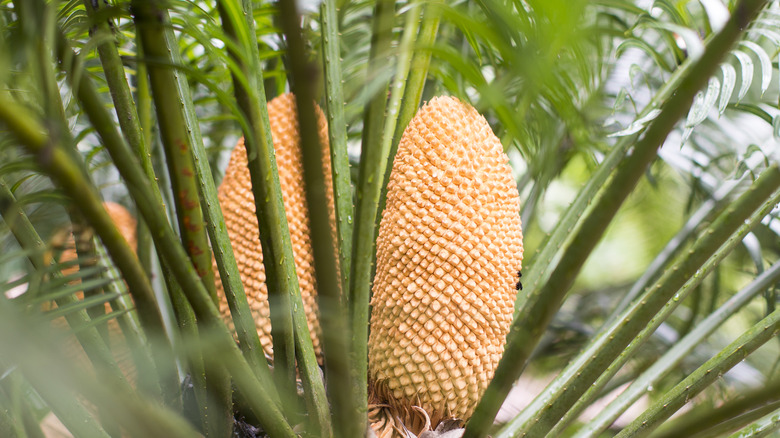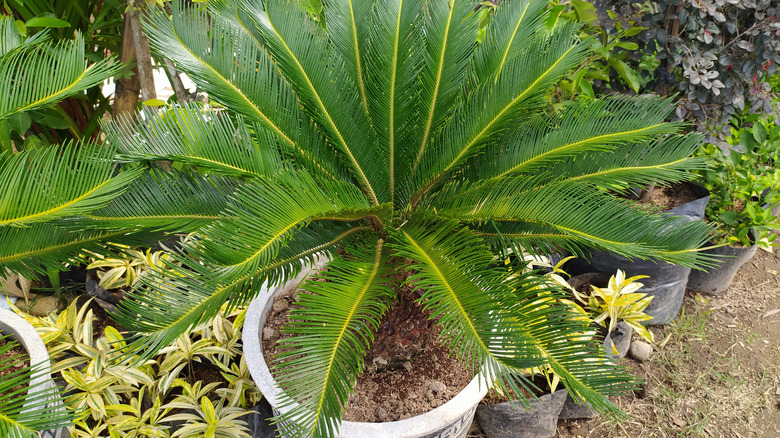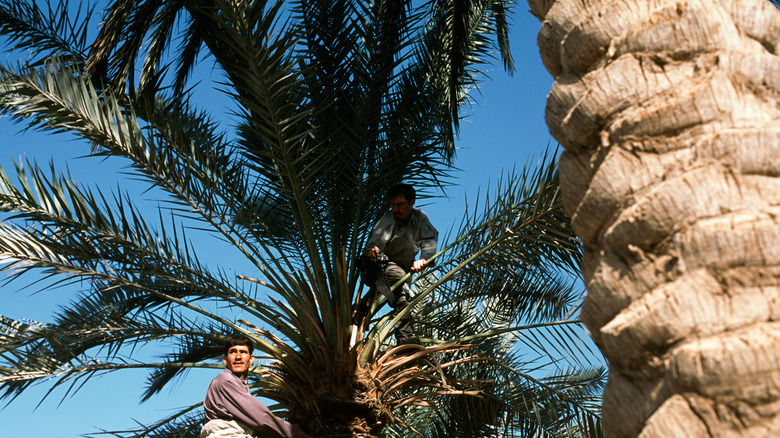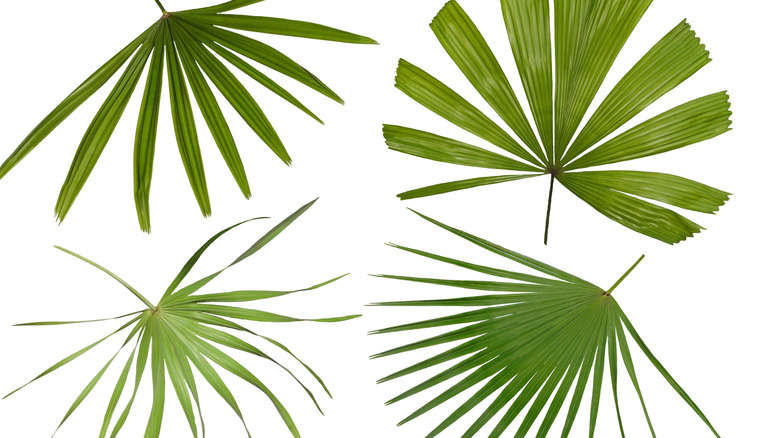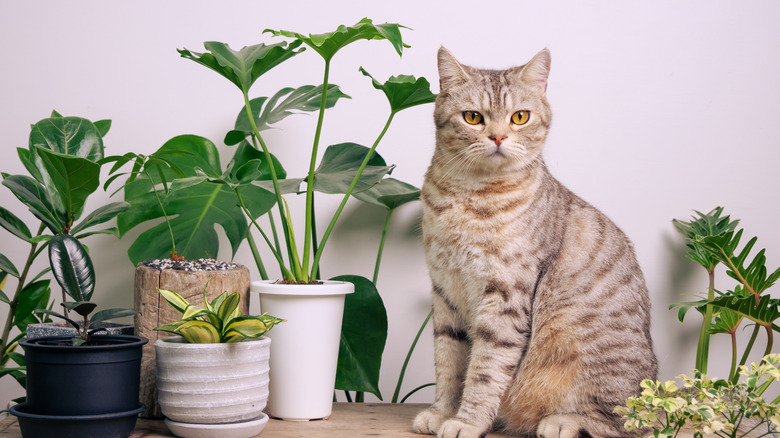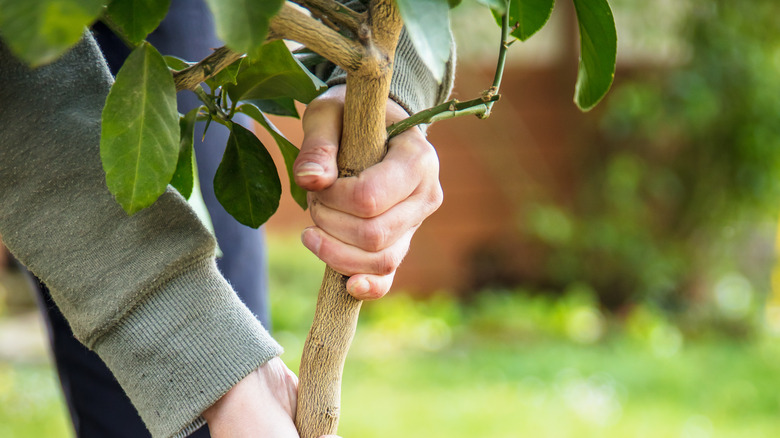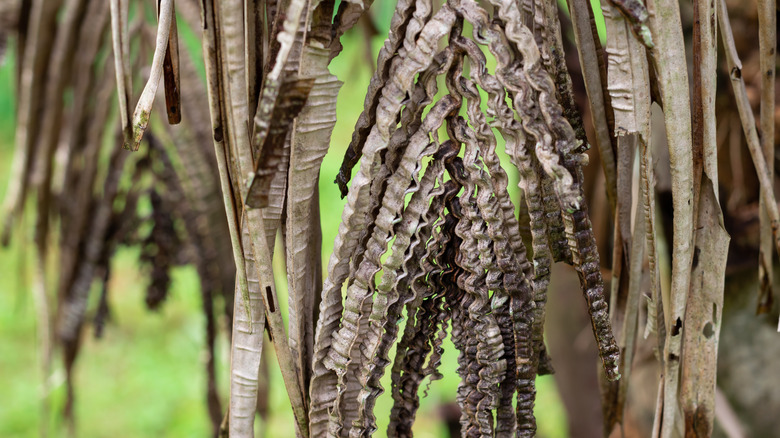How To Grow And Take Care Of A Queen Palm Plant
In cities where climates permit, stately tall queen palm plants line properties both residential and commercially. With its tropical influence and fan palm leaves, these majestic plants, known as Syagrus Romanzoffiana, according to Better Homes & Gardens, thrive in full sun, and make for an attractive look, as seen lining streets in popular cities like Los Angeles. A great choice for landscaping, the easy to care for plants are ornamental and create an upscale look.
Grown from seeds, Queen Palm plants produce ornamental dates, which are on full display during the winter months, and according to Jungle Music, squirrels are found to feast on the seasonal fruit of these plants. Whether used to adorn a business or a home, the statuesque plants tend to make the most modest of homes stand out, and the most opulent of homes appear even more spectacular. If planted and cared for properly, the queen palm has a lifespan of 70 to 100 years, according to The Spruce.
How to use queen palm in garden
There are various ways to use the queen palm plant in the garden. The plants are majestic as standalone landscapes, particularly when they are in bloom with their fruit; however, surrounded by other tropical plants or annuals, the options are endless, as is the beauty and majesty of the queen palm. Better Homes & Gardens offers a few ideas for how to use the palm in the garden, including using them in and around the patio area as well as your recreational area.
If you have a small yard with a queen palm plant, it's also ideal for using circular benches around it to create an outdoor seating area while enjoying the shade of the exotic fronds. The plants can also be used as a backdrop for other varieties of tropical green plants in addition to colorful blooming flowers creating a tropical oasis in the garden.
How to grow queen palm plant
Queen palm plants are among the many popular plants selected for residences and commercial properties. If you are interested in growing your own plant, this is very doable. You need only follow a few tips to ensure the successful growth of your plant. If growing a plant in your yard, select an area where it can reach a maximum height and width of at least 50 feet high with a width of about 25 feet. You can also start off in a container and later transplant it into the ground.
Easily enough, queen palm plants can be grown from a seed once cleaned of all pulp and prior to the fruit ripening. Growth takes place anywhere from six weeks to six months, according to Ask IFAS. They further state plants grown from seeds do best in hot temperatures and are required for germination to occur. It is suggested that soils high in alkaline are not ideal for growth but rather create or buy a palm plant soil mix formulated for the queen palm. Sandy soils are, in fact, ideal for growing. You should keep the plant well-watered and ensure it gets lots of light. As your plant continues to thrive, it is necessary to prune dead fronds as well as to remove the fruit from the to avoid further cleanup.
How to care for queen palm plant
If you have queen palm plants in your yard, it's important to know how to care for them. And the health of the fronds is one of the things that gives notice of an underlying problem, as they will turn brown or have brown spots on them. It's important to examine the plant periodically for any form of disease, especially if a professional is not caring for them. Gardening Know How offers tips on how to care for the queen palm to keep it healthy and beautiful. They state the importance of keeping the plant moist. If in a desert area or other extremely hot area, the plant requires being tended to and kept watered.
Though the care of the plant is easy based on their information, it does require acidic soil. You can always buy test equipment to test the soil to ensure the plant can thrive. Other tips included keeping the area at the base of the trunk clear from any type of debris, particularly turf, to prevent decay. Additionally, the queen palm requires fertilizer periodically. If unsure of what type of fertilizer to use, check with your local nursery, as most of them have an in-house expert that can assist in purchasing the most effective product to enhance the life and health of your queen palm.
Queen palm plant varieties
Where there are over 40 species of queen palms, according to Jungle Music, there are three varieties that differ in size and appearance. Both tall and dwarfed, the desirable ornamental plants bring a tropical look to any business or home. Native to Brazil and several other South American countries, they have the ability to grow in mountainous regions and low-lying regions with extreme growth. Each of these palms is well suited for growing in zones 10 to 11.
-
Arikury is one of the smaller palms used in gardens as an ornamental plant. The width of the fronds extends up to approximately 6 feet as they tend to grow upward. They also have a unique spiral pattern on the gray trunk and a nickname of the Parrot Beak Palm because of the lack of a crown, according to the South Florida Plant Guide. This variety grows up to approximately 10 feet.
-
Licury variety of queen palm plants grows up to 35 feet high, according to The Spruce, and is unique in its leaves coloring, which ranges from green to silver tones.
-
Overtop Palm variety of queen palms is one of the largest plants growing up to 60 feet in height. Preferring acidic soil, this particular variety is not especially drought tolerant. It is also native to the West Indies, according to Jungle Music.
Is queen palm toxic?
As with all plants, it is advisable to know what you can and cannot have around your pet. Though queen palm plants are not toxic to animals, they are also not an ideal choice for animals to nibble on. In fact, fronds can have sharp edges on them, which could injure an animal or human, so it's best to keep them out of the way of the pet's and children's reach.
Another concern is the nut that comes from the plant. The seeds are hard and could, if swallowed, cause choking, as well as create a breathing issue by blocking an opening. If your animal should come into contact with any parts of a queen palm, it is advisable to watch their behavior for any signs of distress. Other parts of the plant in addition to the seeds can cause upset stomach and even blockages in your pets digestive system, according to Hunker.
How to repot queen palms
If you have grown a queen palm plant in a container and are in need of repotting it, you need only follow a few steps to ensure its continued growth. You will know your plant needs to be repotted if you take the time to examine the drain hole of the pot. You can easily spot roots as they begin to grow out of the hole. First, get a pot that has a great drainage hole and is at least twice the size of the old container. Have your new container prepared with fresh, alkaline-free soil and the space already carved out to place the plant in. Take care in removing the plant from the original pot so as not to damage the root system.
If your living space and choices are more conducive to container growing, SFGate highly recommends using soil that is easy to drain. They also suggest keeping the soil at the previous level as the original pot. Water the plant well the first week, but allow the top 2 inches to dry out before watering again. Additionally, they suggest a high potassium slow-release fertilizer to the soil for your newly transplanted queen palm. Keep in mind that plants in containers don't receive the nutrients from the earth, therefore, fertilizer is a must.
How to use fertilizer with queen palm plant
One of the best ways to ensure your queen palms plant is healthy is by managing a fertilizer schedule to ensure maximum growth. According to Garden Guides, there is a specific formulation used for these plants. Known as palm special, according to the site, there are a number of chemicals involved that promote health, nutrition, and growth in the plant. These include a cocktail of healthy nutrients, each of which contributes to the care of the plant and is paramount to the successful growth and life of the plant.
They highly suggest wearing rubber gloves when handling fertilizer and, as always, to consult the product label for dangers and for use. Garden Guides suggests fertilizing at least 2 feet from the trunk of the plant and 1 foot past the tips of the crown fronds. If you find you are uncomfortable fertilizing your queen palm, you can hire a professional to care for them.
Pests and diseases of queen palm
One of the visual signs that your queen palm plant has issues is when the fronds on the plant start to turn brown or simply fall off. There are a number of reasons why this happens, including overwatering or underwatering. Your plant may have also outgrown the space it is in. This is particularly true if in a container. Other signs of diseases in the plant include yellowing of the leaves which means your plant needs more potassium and magnesium, according to Florida Today.
In terms of bugs and pests, according to the San Diego Horticultural Society, these popular plants are relatively resistant and tend not to be bothered by diseases and pests. They do state, however, that the plant does have a few issues to contend with, including pink rot, ants, and the scale insects, and have even been known to be attacked by mysterious unknown diseases. They suggest getting in control of the ant situation, which subsequently takes care of scales. With proper care, the right plant food and pruning help to keep your queen palm healthy.
